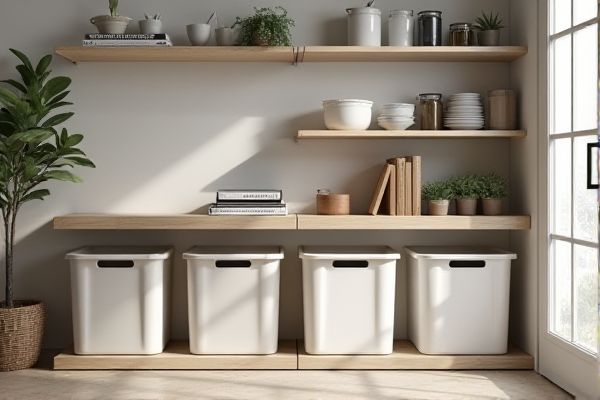
Shelf risers elevate items to improve visibility and accessibility, making them ideal for maximizing vertical space on shelves. Stackable bins offer organized storage with easy stacking and portability; discover which option best suits your space by reading the full article.
Table of Comparison
| Feature | Shelf Risers | Stackable Bins |
|---|---|---|
| Purpose | Increase vertical shelf space | Organize items in stackable containers |
| Material | Plastic, wood, metal | Plastic, often transparent |
| Size Options | Varied to fit shelf dimensions | Multiple sizes and shapes |
| Visibility | Open, items visible on shelves | Often transparent for easy identification |
| Stacking Ability | No, designed to create additional shelf layers | Yes, bins securely stack on each other |
| Use Cases | Kitchen, office, pantry shelf organization | Small parts storage, craft supplies, toys |
| Cost | Generally low to moderate | Moderate, depending on size and material |
| Installation | No tools required, place on existing shelves | No tools required, simply stack |
Introduction to Shelf Risers and Stackable Bins
Shelf risers enhance vertical storage space by elevating items on existing shelves, allowing better visibility and access to your belongings. Stackable bins provide modular storage solutions that can be securely stacked to maximize organization in closets, garages, or offices. Both options optimize space efficiently but serve different purposes based on your storage needs and available area.
Key Differences Between Shelf Risers and Stackable Bins
Shelf risers elevate existing shelf space to increase vertical storage area, making it easier to organize items without taking up additional floor space. Stackable bins offer modular, contained storage units that can be piled securely, ideal for categorizing smaller items and maximizing horizontal and vertical organization simultaneously. Choosing between shelf risers and stackable bins depends on your need for elevation versus enclosed storage to optimize your space effectively.
Space Efficiency: Shelf Risers vs Stackable Bins
Shelf risers maximize vertical space by creating additional tiers on existing shelves, enhancing visibility and accessibility without expanding the storage footprint. Stackable bins offer modular storage by allowing items to be securely nested on top of each other, optimizing floor and shelf space by consolidating smaller items within contained units. Choosing between shelf risers and stackable bins depends on the type of items stored and the need for easy access versus compact, contained organization.
Best Use Cases for Shelf Risers
Shelf risers excel in maximizing vertical space within cabinets and closets, making them ideal for organizing kitchenware, pantry items, and office supplies. Their design allows easy visibility and access, perfect for items like plates, canned goods, and small appliances. You can efficiently create multiple tiers without compromising storage capacity, enhancing both order and convenience in your space.
Ideal Scenarios for Stackable Bins
Stackable bins are ideal for maximizing vertical storage in small spaces like pantries, garages, or closets, allowing you to efficiently organize items without the need for permanent fixtures. Their modular design enables easy customization and quick access to frequently used supplies, making them perfect for both home and office environments. Choosing stackable bins can optimize your storage by providing flexibility and visibility while keeping items secure and accessible.
Material and Durability Comparison
Shelf risers typically feature a sturdy metal or heavy-duty plastic construction designed to support heavier weights and resist deformation over time, making them ideal for long-term durability in kitchen or office settings. Stackable bins are often made from lighter plastic materials, which offer flexibility and ease of handling but may be more prone to cracking or warping under heavy loads or frequent use. The choice between the two depends largely on the intended application: shelf risers provide enhanced strength and stability, while stackable bins prioritize modular storage with moderate durability.
Ease of Access and Organization
Shelf risers enhance ease of access by elevating items, making them more visible and reachable without needing to move other objects. Stackable bins offer superior organization through compartmentalization, allowing you to separate and store items neatly while maximizing vertical space. Your choice depends on whether quick access or segmented storage better suits your needs.
Cost Analysis: Investment and Longevity
Shelf risers offer a cost-effective investment with low upfront expenses and durable materials that extend longevity, making them ideal for long-term storage solutions. Stackable bins, while sometimes more expensive initially, provide versatile organization and protect contents from dust and damage, potentially reducing replacement costs over time. Evaluating total cost of ownership reveals shelf risers excel in durability and basic storage expansion, whereas stackable bins justify higher costs through enhanced protection and modular stacking benefits.
Aesthetic Impact on Home and Office Spaces
Shelf risers create an open, airy look by elevating items without enclosing them, enhancing the visual appeal of minimalist and modern home or office spaces. Stackable bins offer a more structured, uniform appearance that helps conceal clutter, making your storage look streamlined and organized. Choosing between them depends on whether you prioritize a sleek, decorative display or a neat, hidden storage solution to complement your decor.
Choosing the Right Storage Solution for Your Needs
Shelf risers maximize vertical space by elevating items for easy visibility and access, making them ideal for organizing kitchens or offices with limited shelf height. Stackable bins provide modular storage with secure stacking, perfect for categorizing smaller items or maximizing closet and garage organization. You can optimize your storage by assessing your space constraints and the types of items you need to store.
 homyna.com
homyna.com